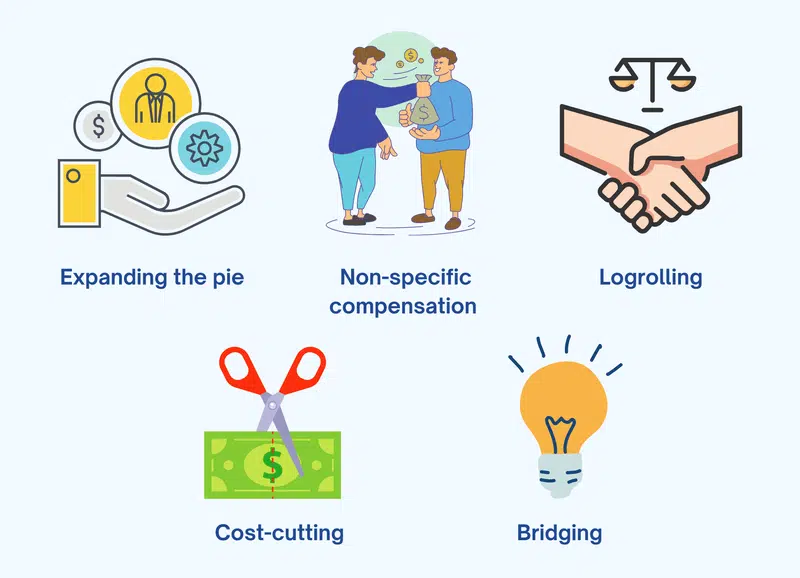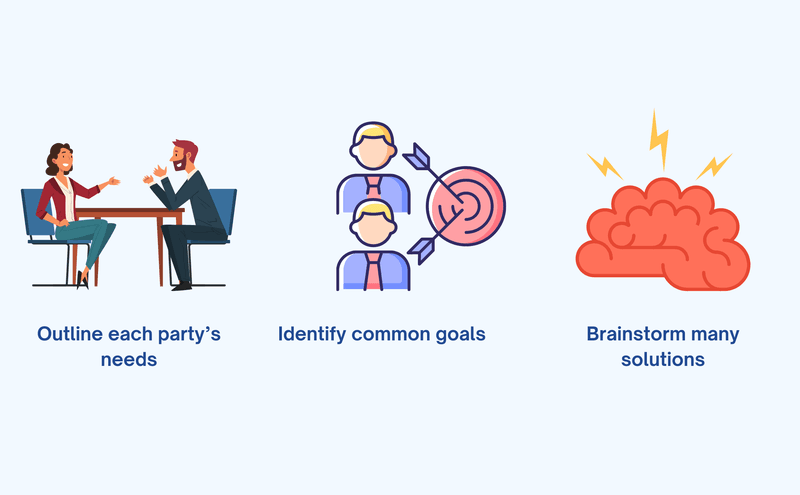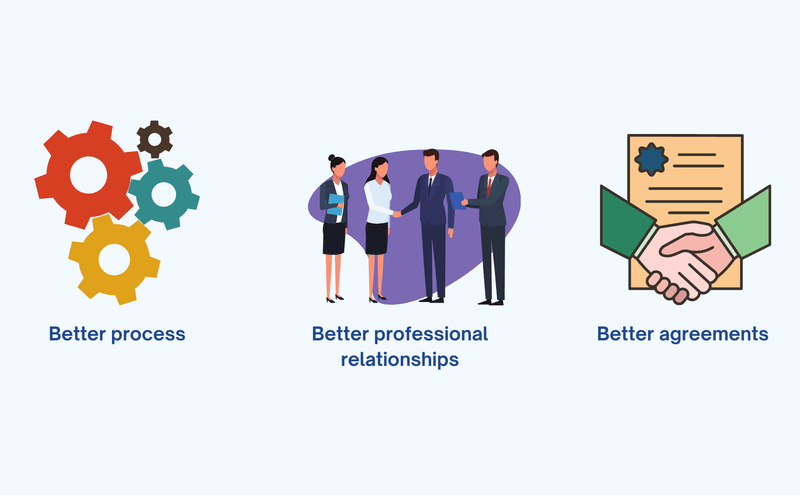A person comes across negotiations at all stages of life. As a child, one enters into a negotiation with their parent regarding playtime. Sometimes, a child can cry or throw a tantrum to have his way. Unfortunately, as one grows older, things tend to get more complex. So, it becomes essential to pick up negotiation skills as you move through the different stages of life. This article will look at various types of integrative negotiation and how people apply them successfully to different situations.
Table of contents:
- What is Negotiation?
- What Is Integrative Negotiation?
- Is Integrative Negotiation the Same As Integrative Bargaining?
- What Are The Types of Integrative Negotiation?
- How to Use Integrative Negotiation in the Workplace?
- Keys to a Successful Integrative Negotiation
- Advantages of Integrative Negotiation
- Disadvantages of Integrative Negotiation
What is Negotiation?
Negotiation is a discussion where two parties that have reached a deadlock try to find a solution. It is a vital tool for any business. It is an influential communication process that can be used to reach agreements and consensus between two or more parties. Negotiations are essential in almost all areas of life, from corporate deals to political diplomacy and everyday conversations with friends and family.
The negotiation process involves steps that help the parties involved reach a mutually beneficial agreement. This includes researching the issue at hand, understanding both sides’ needs and interests, developing options for compromise, finding alternatives, communicating effectively, setting expectations, making concessions if necessary, and finally reaching a win-win solution. Practical negotiating skills can significantly improve your chances of success in any situation!
One of the most known types of negotiation the integrative negotiation. So, without further ado, let’s learn more about it.
What Is Integrative Negotiation?
Integrative negotiation is also known as integrative bargaining or win-win bargaining. Typically, more than one issue has to be solved in these situations. It works by having both parties strive for a mutually beneficial solution rather than competing over a single result. This means that each side considers its objectives and those of the other party to reach an agreement that suits everyone’s needs. It also involves looking at possible compromises or tradeoffs and finding solutions for everyone.
However, it is essential to note that the goals in this type of negotiation are not mutually exclusive. Since the problem involves collaboration, methods such as brainstorming and active listening are used in integrative negotiation.
There are two core aspects to integrative negotiations. Firstly, the parties must discuss the real issues becoming the bone of contention. These are the problems that need to be addressed and negotiated.
Secondly, there is the question of the intrinsic value of the contract. This is basically the long-term relationship and goodwill between the two parties.
One must also note that the integrative negotiation technique can only be used when many issues require a resolution. This allows the stakeholders to make tradeoffs on different topics.
Is Integrative Negotiation the Same As Integrative Bargaining?
Integrative negotiation and integrative bargaining are two terms that may sound different, but they refer to the same type of negotiation. This negotiation method focuses on creating an agreement between two or more parties to benefit all involved. While it is possible to use other negotiation methods, integrative negotiation is often seen as the most successful way to negotiate a fair outcome.
What Are The Types of Integrative Negotiation?
This section will look at the different types of integrative negotiation techniques.

Expanding the pie
In some cases, conflicts arise due to a lack of resources. So, the solution is arrived at by increasing the resources available. This will help everyone achieve their goals. But the important thing is that all the parties involved must work together.
An example is when the sales team asks for a raise, but there is a budget crunch. So, the entire team comes together and decides on a sales-based commission system. For every extra sale the team would make, they would get additional payments.
Non-specific compensation
Let us assume there are two parties here – party A and party B. In this situation, party B can buy off compensations from party A. To do this, they offer party A something unrelated to the source of the conflict. This happens when party A realizes they might want or need something party B has.
One party pays off the other party. Now the other party can use the payoff however they want.
Logrolling
Suppose there are two parties in a negotiation – party A and party B. Two different issues are bothering both parties – issue 1 and issue 2. Issue 1 may be critical to party A, and Issue 2 might be shallow on their priority list.
The case with party B might be just the opposite. Here it is a win-win for both parties. Non-specific compensation is also seen as a kind of log rolling.
For instance, a colleague of yours gets a promotion. Let’s call him Jim. Jim now gets a bigger office. Now you and another colleague, James, want Jim’s office.
However, both of you have different reasons for it. James wants the office for the fancy wooden bookcases. You want that office for the large windows and the incredible view. You shift the bookcases to James’ office and occupy Jim’s office to solve this problem.
Cost-cutting
Sometimes when the other party agrees to your demand, they incur a cost. It is known as cost-cutting if you can help them reduce their costs.
In the above example, you are left without bookcases in the office. So, James agrees to give his metal bookcases to you. In this way, he reduces your costs and saves you the trouble of getting new bookcases for your office.
Bridging
Briding or bridge solutions involve both parties coming up with new solutions. These new solutions are different from the original demand. However, the new solution that both teams have arrived at after a mutual consensus is a way to satisfy the requirements of both parties.
Here is an example of a bridge solution. The marketing department and information technology want to speak about their respective departments. There is one speaking slot at a prestigious industry conference.
To highlight the progress of both departments and keep everyone happy, a decision is made to speak about a successful marketing campaign showcasing the firm’s IT solutions.
How to Use Integrative Negotiation in the Workplace?
Now that we understand integrative negotiation, let us look at how this technique is helpful in the workplace.

Outline each party’s needs.
Understanding the concerns of each of the parties involved is essential before concluding.
One way to start the meeting is to ask the parties about the issues they want to discuss. The parties can then be asked to list their demands. The entire process can take place in a back-and-forth manner. To do this, each party can be asked to submit their request, one at a time, to get equal opportunities to speak. This allows for a better discussion and resolution of the situation.
Identify common goals
In this step, the end goals of both parties are up for discussion. This way, the mediator can create a list of goals and identify the common ones among them. It becomes easier to find a middle ground between these two parties.
Brainstorm Many Solutions
In this step, the mediator and the parties involved must work together to develop as many solutions as possible.
One must never forget that the solutions must mutually benefit both parties. When one side comes up with a solution, they can share it with their counterparts and discuss the finer points. This makes it easier to conclude.
Keys to a Successful Integrative Negotiation
Here we look at the components of a successful integrative negotiation.

The willingness of both parties to participate
This is the most crucial aspect for any negotiation to succeed. Both parties must agree to a discussion to resolve their issues. Also, they must be patient while listening to the other side’s concerns. The focus must be on mutual gains. If neither party is willing to compromise, there cannot be any progress.
Collaborative atmosphere
Both parties must holistically look at the issue. This is essential to ensure mutual gains for everyone involved in the process. One must never forget to consider the pressing issues of the other side. Also, it is important not to assume that one understands the ‘real’ needs of the other party.
Recognize the relationship
The parties involved in this negotiation must realize that they have a relationship they would like to maintain after this process has ended. This means that the people understand there are more important things at stake than a one-time gain. Also, it underlines the fact that the negotiators value their relationship.
Package the issues
When several problems are bundled into one package, it enhances clarity for both parties. This also speeds up the process as repeated or redundant issues are discarded or resolved.
Advantages of Integrative Negotiation
In this section, let us explore the plus points of the integrative negotiation tactic.

It enhances the negotiation process.
While using this technique, each party considers the other side’s needs. This is to find a mutually beneficial solution. So, this method creates a friendly environment between the two parties and avoids escalating the conflict.
It improves professional relationships.
Since there are fewer conflicts in this process, the relationship between the negotiating parties gets better. Also, the successful conclusion of the negotiation adds to this feeling. This leads to more business opportunities for both parties in the future.
It leads to better agreements.
Each party and the mediator consider the other party’s interests before deciding. So, integrative negotiation is more likely to result in acceptable agreements for both parties. Also, this means that there are more chances for both parties to follow the terms of the agreement.
Disadvantages of Integrative Negotiation
Despite all the advantages, there are some downsides to integrative negotiation.

Firstly, it can be time-consuming to agree. Also, there could be a lot of time to resolve minor issues. Sometimes, the other party takes advantage of their confidence in you.
As a mediator, one may believe they have come up with the most optimal solution to the problem. However, in reality, that may not be the case. Furthermore, maintaining the perfect balance of power between the two is vital to arriving at a mutually beneficial solution.
Finally, a mediator might not listen to both sides properly due to overconfidence in his abilities. So, the conclusion might not be acceptable to either of the parties.
In Conclusion
Integrative negotiation is an excellent strategy if both parties know their needs. This also means being clear about what they are willing to give up. Finally, transparency, information symmetry, and trust in the whole process are pivotal to smooth negotiations.

Ranu Kumari is a Professional Writer and a Marketing enthusiast who currently runs her own Marketing Consultancy, LatitudeBOX. She has written promotional articles for multiple brands and has published her work in Scopus indexed journals. She is passionate about expressing her thoughts and ideas to connect with her readers in a voice that they understand.
